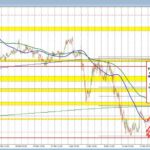CPI and Inflation: Understanding Japan’s Economic Implications
Tháng 4 16, 2025
USD/CAD: Navigating Recent Dips and Technical Trends Ahead of BoC Rate Decision
Tháng 4 16, 2025U.S. Crude Oil Inventories Show Surprise Increase, Market Faces Volatility
Recent data regarding U.S. crude oil inventories has revealed notable fluctuations that have caught the attention of analysts and investors alike. For the week ending April 11, 2025, the American Petroleum Institute (API) reported an unexpected rise in crude oil inventories by 2.4 million barrels. This deviation from market expectations of a 1.68 million-barrel draw signals a complex trend in the oil market, currently marred with uncertainty.
Analysis of Inventory Trends
In the preceding week, ending April 4, 2025, U.S. commercial crude oil inventories had already witnessed an increase. The API indicated a rise of 2.6 million barrels, bringing total inventories to 442.3 million barrels. This current level is significant, being 5% below the five-year average for this time of year, which suggests that while there is an uptick in inventories, the overall historical context shows a tighter market environment.
Interestingly, crude oil refinery inputs averaged 15.6 million barrels per day during this period, reflecting a solid demand from refineries despite the inventory increases. This could indicate that refineries are adjusting to the rising stock levels, likely to position themselves effectively ahead of anticipated market conditions.
Future Implications on Oil Prices
The EIA’s Short-Term Energy Outlook has forecasted that global oil inventories will likely increase by mid-2025. This anticipated increase is expected to be driven by higher production rates amid a backdrop of slowed demand growth. Analysts propose that such developments could lead to a reduction in oil prices, which have hovered unpredictably as a result of varying market dynamics.
The intricate interplay of trade policies, geopolitical events, and supply adjustments further exacerbates the volatility in oil prices. Industry observers must pay close attention to how these elements might affect future inventory changes and oil prices. Given the recent four-week streak of inventory builds, any signs of sustained production increases or sharp drops in demand could push crude prices lower, affecting everything from consumer gasoline prices to broader economic indicators.
For investors navigating this complex environment, understanding the fundamentals of value investing becomes crucial. According to a recent analysis, seeking undervalued stocks and maintaining a long-term mindset may help investors weather the storm of fluctuating oil prices, as outlined in the blog on 3 reasons Greenblatt says value investing beats the market.
Conclusion
The observations regarding U.S. crude oil inventories highlight critical shifts in market dynamics that stakeholders need to monitor closely. The unexpected rise in inventories, contrasted with the solid refinery inputs, indicates a complex landscape that does not favor simplistic analyses. As the EIA projects potential increases in global oil inventories, the market braces itself for further fluctuations that could redefine oil pricing structures in the foreseeable future. Stakeholders in the energy market should remain vigilant in adapting strategies responding to these swift changes, as the ramifications of fluctuating inventories extend far beyond oil prices, influencing the entire economy.
Investors and analysts alike should keep an eye on upcoming data releases, trade developments, and global economic indicators, as these will provide pivotal insight into how the oil market will evolve throughout the year. They should also be aware of potential investment mistakes to avoid amidst this volatility to ensure long-term financial success.
